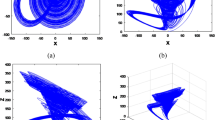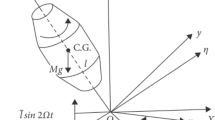Abstract
This paper focuses on the modeling and symmetry breaking analysis of the large class of chaotic electronic circuits utilizing an antiparallel diodes pair as nonlinear device necessary for chaotic oscillations. A new and relatively simple autonomous jerk circuit is used as a paradigm. Unlike current approaches assuming identical diodes (and thus a perfect symmetric circuit), we consider the more realistic situation where both antiparallel diodes present different electrical properties in spite of unavoidable scattering of parameters. Hence, the nonlinear component synthesized by the diodes pair exhibits an asymmetric current–voltage characteristic which engenders the explicit symmetry break of the whole electronic circuit. The mathematical model of the new circuit consists of a continuous time 3D autonomous system with exponential nonlinear terms. We investigate the chaos mechanism with respect to model parameters and initial conditions as well, both in the symmetric and asymmetric modes of operation by using bifurcation diagrams and phase space trajectories plots as main indicators. We report period doubling route to chaos, spontaneous symmetry breaking, merging crisis and the coexistence of two, four, or six mutually symmetric attractors in the symmetric regime of operation. More intriguing and complex nonlinear behaviors are revealed in the asymmetric system such as coexisting asymmetric bubbles of bifurcation (a new kind of phenomenon discovered in this work), hysteretic dynamics, critical phenomena, and coexisting multiple (i.e. two, three, four, or five) asymmetric attractors for some appropriately selected values of parameters. Laboratory experimental tests are conducted to support the theoretical analysis. The results obtained in this work clearly indicate that chaotic circuits with back to back diodes can demonstrate much more complex dynamics than what is reported in the relevant literature and thus should be reconsidered accordingly following the method described in this paper.

























Similar content being viewed by others
References
Chen, X., Lin, Y., & Bao, B. (2017). Multistability induced by two symmetric stable node-foci in modified canonical Chua’s circuit. Nonlinear Dynamics,87, 789–802.
Maggio, G. M., De Feo, O., & Kennedy, M. P. (1999). Nonlinear analysis of the Colpitts oscillator and application to design. IEEE Transactions on Circuits and Systems I: Fundamental Theory and Applications,46, 1118–1130.
Freire, E., Franquelo, L. G., & Aracil, J. (1994). Periodicity and chaos in an autonomous electrical system. IEEE Transactions on Circuits and Systems,31(3), 237–247.
Kengne, J., Njitacke, Z. T., Nguomkam, N. A., Fouodji, T. M., & Fotsin, H. B. (2015). Coexistence of multiple attractors and crisis route to chaos in a novel chaotic jerk circuit. International Journal of Bifurcation and Chaos,25(4), 1550052.
Fozin, F. T., Kengne, J., & Pelap, F. B. (2018). Dynamical analysis and multistability in autonomous hyperchaotic oscillator with experimental verification. Nonlinear Dynamics,93(2), 653–669.
Jeevarekha, A., Sabarathinam, S., Thamilmaran, K., & Philomenathan, P. (2016). Analysis of a 4D autonomous system with volume-expanding phase space. Nonlinear Dynamics,84(4), 2273–2284.
Kengne, J., Tabekoueng, Z. N., & Fotsin, H. B. (2016). Coexistence of multiple attractors and crisis route to chaos in autonomous third order Duffing–Holmes type chaotic oscillators. Communications in Nonlinear Science and Numerical Simulation,36, 29–44.
Leutcho, G. D., Kengne, J., & Kamdjeu, K. L. (2018). Dynamical analysis of a novel autonomous 4-D hyperjerk circuit with hyperbolic sine nonlinearity: Chaos, antimonotonicity and a plethora of coexisting attractors Chaos. Solitons and Fractals,107, 67–87.
Kahllert, C. (1993). The effects of symmetry breaking in Chua’s circuit and related piecewise-linear dynamical system. International Journal of Bifurcation and Chaos,3(4), 963–979.
Dana, S. K., Chakraborty, S., & Ananthakrishna, G. (2005). Homoclinic bifurcation in Chua’s circuit. Pramana Journal of Physics,64(3), 44344.
Cao, H., Seoane, J. M., & Sanjuan, M. A. F. (2007). Symmetry-breaking analysis for the general Helmholz–Duffing oscillator. Chaos, Solitons & Fractals,34, 197–212.
Sofroniou, A., & Bishop, S. R. (2006). Breaking the symmetry of the parametrically excited pendulum. Chaos, Solitons & Fractals,28, 673–681.
Bishop, S. R., Sofroniou, A., & Shi, P. (2005). Symmetry-breaking in the response of the parameterically excited pendulum model. Chaos, Solitons & Fractals,25(2), 27–264.
Rynio, R., & Okninski, A. (1998). Symmetry breaking and fractal dependence on initial conditions in dynamical systems: Ordinary differential equations of thermal convection. Chaos, Solitons & Fractals,9(10), 1723–1732.
Henrich, M., Dahms, T., Flunkert, V., Teitsworth, S. W., & Scholl, E. (2010). Symmetry breaking transitions in networks of nonlinear circuits elements. New Journal of Physics,12, 113030.
Cao, H., & Jing, Z. (2001). Chaotic dynamics of Josephson equation driven by constant and ac forcings. Chaos, Solitons & Fractals,12, 1887–1895.
Kengne, J., Njitacke, Z. T., & Fotsin, H. B. (2016). Dynamical analysis of a simple autonomous jerk system with multiple attractors. Nonlinear Dynamics,83, 751–765.
Kengne, J., Folifack Signing, V. R., Chedjou, J. C., & Leutcho, G. D. (2017). Nonlinear behavior of a novel chaotic jerk system: Antimonotonicity, crises, and multiple coexisting attractors. International Journal of Dynamics and Control,6, 468–485. https://doi.org/10.1007/s40435-017-0318-6.
Kengne, J., Njikam, S. M., & Folifack, V. R. (2018). A plethora of coexisting strange attractors in a simple jerk system with hyperbolic tangent nonlinearity. Chaos, Solitons & Fractals,106, 201–213.
Njitacke, Z. T., Kengne, J., Fotsin, H. B., Nguomkam Negou, A., & Tchiotsop, D. (2016). Coexistence of multiple attractors and crisis route to chaos in a novel memristive diode bridge-based Jerk circuit. Chaos, Solitons & Fractals,91, 180–197.
Kengne, J., & Mogue, R. L. T. (2018). Dynamic analysis of a novel jerk system with composite tanh-cubic nonlinearity: Chaos, multi-scroll, and multiple coexisting attractors. International Journal of Dynamics and Control. https://doi.org/10.1007/s40435-018-0444-9.
Kingni, S. T., Pone, J. R. M., Kuiate, G. F., & Pham, V. T. (2019). Coexistence of attractors in integer-and fractional-order three-dimensional autonomous systems with hyperbolic sine nonlinearity: Analysis, circuit design and combination synchronization. Pramana,93(1), 12.
Joshi, M., & Ranjan, A. (2019). An autonomous chaotic and hyperchaotic oscillator using OTRA. Analog Integrated Circuits and Signal Processing,101(3), 401–413.
Tamaševičius, A., Bumelienė, S., Kirvaitis, R., Mykolaitis, G., Tamaševičiūtė, E., & Lindberg, E. (2009). Autonomous Duffing–Holmes type chaotic oscillator. Elektronika ir Elektrotechnika,3(5), 43–46.
Joshi, M., & Ranjan, A. (2019). New simple chaotic and hyperchaotic system with an unstable node. AEU-International Journal of Electronics and Communications,108, 1–9.
Pone, J. R. M., Çiçek, S., Kingni, S. T., Tiedeu, A., & Kom, M. (2020). Passive–active integrators chaotic oscillator with anti-parallel diodes: Analysis and its chaos-based encryption application to protect electrocardiogram signals. Analog Integrated Circuits and Signal Processing,103, 1–15.
Sprott, J. C. (2011). A new chaotic jerk circuit. IEEE Transactions on Circuits and Systems II: Express Briefs,58, 240–243.
Louodop, P., Kountchou, M., Fotsin, H., & Bowong, S. (2014). Practical finite-time synchronization of jerk systems: Theory and experiment. Nonlinear Dynamics,78, 597–607.
Hanias, M. P., Giannaris, G., & Spyridakis, R. A. (2006). Time series analysis in chaotic diode resonator circuit. Chaos, Solitons & Fractals,27, 569–573.
Sukov, D. W., Bleich, M. E., Gauthier, J., & Socolar, J. E. S. (1997). Controlling chaos in a fast diode resonator using extended time-delay autosynchronization: Experimental observations and theoretical analysis. Chaos,7, 560–576.
Sprott, J. C. (2010). Elegant chaos: Algebraically simple flow. Singapore: World Scientific Publishing.
Li, C., & Sprott, J. C. (2013). Amplitude control approach for chaotic signals. Nonlinear Dynamics,73, 1335–1341.
Strogatz, S. H. (1994). Nonlinear dynamics and chaos. Reading: Addison-Wesley.
Nayfeh, A. H., & Balachandran, B. (1995). Applied nonlinear dynamics: Analytical, computational and experimental methods. New York: Wiley.
Kuznetsov, Y. A. (1995). Elements of applied bifurcation theory. New York: Springer.
Leonov, G., Kuznetsov, N., & Vagaitsev, V. (2012). Hidden attractor in smooth Chua systems. Physica D: Nonlinear Phenomena,241(18), 1482–1486.
Leonov, G. A., Kuznetsov, N. V., & Mokaev, T. N. (2015). Homoclinic orbits, and self-excited and hidden attractors in a Lorenz-like system describing convective fluid motion. European Physical Journal Special Topics,224, 1421–1458.
Pham, V. T., Jafari, S., Volos, C., Giakoumis, A., Vaidyanathan, S., & Kapitaniak, T. (2016). A chaotic system with equilibria located on the rounded square loop and its circuit implementation. IEEE Transactions on Circuits and Systems II: Express Briefs,6(9), 878–882.
Jafari, S., Sprott, J. C., & Golpayegani, S. M. R. H. (2013). Elementary quadratic chaotic flows with no equilibria. Physics Letters A,377(9), 699–702.
Jafari, S., Pham, V. T., & Kapitaniak, T. (2016). Multiscroll chaotic sea obtained from a simple 3D system without equilibrium. International Journal of Bifurcation and Chaos,26(02), 1650031.
Wolf, A., Swift, J. B., Swinney, H. L., & Wastano, J. A. (1985). Determining Lyapunov exponents from time series. Physica D: Nonlinear Phenomena,16, 285–317.
Bier, M., & Bountis, T. C. (1994). Remerging Feigenbaum trees in dynamical systems. Physics Letters A,104, 239–244.
Dawson, S. P., Grebogi, C., Yorke, J. A., Kan, I., & Koçak, H. (1992). Antimonotonicity: Inevitable reversals of period-doubling cascades. Physics Letters A,162, 249–254.
Kyprianidis, I., Stouboulos, I., Haralabidis, P., & Bountis, T. (2000). Antimonotonicity and chaotic dynamics in a fourth-order autonomous nonlinear electric circuit. International Journal of Bifurcation and Chaos,10, 1903–1915.
Kocarev, L., Halle, K. S., Eckert, K., & Chua, L. O. (1993). Experimental observation of antimonotonicity in Chua’s circuit. International Journal of Bifurcation and Chaos,3(4), 1051–1055.
Kengne, J. (2017). On the dynamics of Chua’s oscillator with a smooth cubic nonlinearity: Occurrence of multiple attractors. Nonlinear Dynamics,87(1), 363–375.
Lai, Q., & Chen, S. (2016). Generating multiple chaotic attractors from Sprott B system. International Journal of Bifurcation and Chaos,26(11), 1650177.
Li, C., & Sprott, J. C. (2014). Coexisting hidden attractors in a 4-D simplified Lorenz system. International Journal of Bifurcation and Chaos,24, 1450034.
Li, C., Hu, W., Sprott, J. C., & Wang, X. (2015). Multistability in symmetric chaotic systems. The European Physical Journal Special Topics,224, 1493–1506.
Leipnik, R. B., & Newton, T. A. (1981). Double strange attractors in rigid body motion with linear feedback control. Physics Letters A,86, 63–87.
Leutcho, G. D., & Kengne, J. (2018). A unique chaotic snap system with a smoothly adjustable symmetry and nonlinearity: Chaos, offset-boosting, antimonotonicity, and coexisting multiple attractors. Chaos, Solitons & Fractals,113, 275–293.
Luo, X., & Small, M. (2007). On a dynamical system with multiple chaotic attractors. International Journal of Bifurcation and Chaos,17(9), 3235–3251.
Pisarchik, A. N., & Feudel, U. (2014). Control of multistability. Physics Reports,540(4), 167–218.
Author information
Authors and Affiliations
Corresponding author
Additional information
Publisher's Note
Springer Nature remains neutral with regard to jurisdictional claims in published maps and institutional affiliations.
Rights and permissions
About this article
Cite this article
Kamdjeu Kengne, L., Kamdem Tagne, H.T., Kengnou Telem, A.N. et al. A broken symmetry approach for the modeling and analysis of antiparallel diodes-based chaotic circuits: a case study. Analog Integr Circ Sig Process 104, 205–227 (2020). https://doi.org/10.1007/s10470-020-01664-3
Received:
Revised:
Accepted:
Published:
Issue Date:
DOI: https://doi.org/10.1007/s10470-020-01664-3




